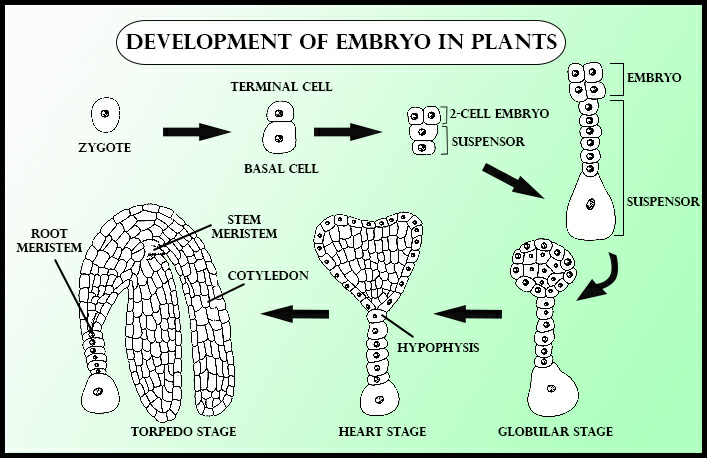
Write down the names of post fertilization events in flowering plants. Describe the process of embryo development in dicots.
Answer
485.1k+ views
Hint: Post-fertilization events refer to a cascade of events taking place in between the formation of zygote and the formation of fruits.
The post-fertilization events are:
-Formation of endosperm
-Formation of embryo
-Formation of seed
-Formation of fruit
Complete Answer:
The process of formation of an embryo from the zygote formed as a result of double fertilization by a series of cell division and differentiation. It occurs within the ovule. A typical dicot embryo consists of two cotyledons formed from the embryonic leaves. They lie on each side of the embryonal axis. The steps involved in embryogenesis are as follows-
-The zygote divides transversally and asymmetrically to form an apical cell and a large basal cell.
-The second division is vertical in the apical cell and transverse in the basal cell. This leads to the formation of a ‘T' shaped ‘proembryo' (four celled structure).
-The proembryo gets converted into a 32-celled globular embryo by transverse and longitudinal division in the upper three cells of proembryo.
-The globular proembryo favors the formation of different organs i.e. organogenesis.
-The outermost layer of the globular proembryo develops into the dermatogen that later gets converted into the epidermis.
-The inner cells of the upper region get converted into the cotyledons and plumule whereas the lower region gets converted into the radicle.
-Since the cotyledons divide faster concerning the plumule the shape becomes heart-shaped.
-The lowermost cell of the basal region divides transversally to form the ‘suspensor cells'. It is responsible for the anchorage of the embryo to the embryonal axis and nutrition of the developing embryo.

Note: The central axis of the embryo situated between the plumule and radicle is known as the embryonal axis. Inside the embryo, the part of the axis above the radicle is called hypocotyl whereas the part of the axis lying below plumule is known as epicotyl.
The post-fertilization events are:
-Formation of endosperm
-Formation of embryo
-Formation of seed
-Formation of fruit
Complete Answer:
The process of formation of an embryo from the zygote formed as a result of double fertilization by a series of cell division and differentiation. It occurs within the ovule. A typical dicot embryo consists of two cotyledons formed from the embryonic leaves. They lie on each side of the embryonal axis. The steps involved in embryogenesis are as follows-
-The zygote divides transversally and asymmetrically to form an apical cell and a large basal cell.
-The second division is vertical in the apical cell and transverse in the basal cell. This leads to the formation of a ‘T' shaped ‘proembryo' (four celled structure).
-The proembryo gets converted into a 32-celled globular embryo by transverse and longitudinal division in the upper three cells of proembryo.
-The globular proembryo favors the formation of different organs i.e. organogenesis.
-The outermost layer of the globular proembryo develops into the dermatogen that later gets converted into the epidermis.
-The inner cells of the upper region get converted into the cotyledons and plumule whereas the lower region gets converted into the radicle.
-Since the cotyledons divide faster concerning the plumule the shape becomes heart-shaped.
-The lowermost cell of the basal region divides transversally to form the ‘suspensor cells'. It is responsible for the anchorage of the embryo to the embryonal axis and nutrition of the developing embryo.

Note: The central axis of the embryo situated between the plumule and radicle is known as the embryonal axis. Inside the embryo, the part of the axis above the radicle is called hypocotyl whereas the part of the axis lying below plumule is known as epicotyl.
Recently Updated Pages
Master Class 12 Economics: Engaging Questions & Answers for Success

Master Class 12 Maths: Engaging Questions & Answers for Success

Master Class 12 Biology: Engaging Questions & Answers for Success

Master Class 12 Physics: Engaging Questions & Answers for Success

Master Class 12 Business Studies: Engaging Questions & Answers for Success

Master Class 12 English: Engaging Questions & Answers for Success

Trending doubts
Which are the Top 10 Largest Countries of the World?

Differentiate between homogeneous and heterogeneous class 12 chemistry CBSE

Draw a labelled sketch of the human eye class 12 physics CBSE

What is the Full Form of PVC, PET, HDPE, LDPE, PP and PS ?

What is a transformer Explain the principle construction class 12 physics CBSE

What are the major means of transport Explain each class 12 social science CBSE




